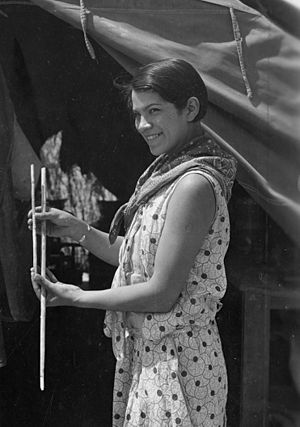Bertha Parker Pallan facts for kids
Quick facts for kids
Bertha Parker Pallan
|
|
|---|---|

Pallan, holding atlatl darts during Southwest Museum, Los Angeles, Gypsum Cave expedition, circa 1930.
|
|
| Born |
Bertha Parker
August 30, 1907 Chautauqua County, New York, United States
|
| Died | October 8, 1978 (aged 71) Los Angeles, California, United States
|
| Spouse(s) | Joseph Pallan (m. 192?; div. 1929/30) James Thurston
(m. 1931; died 1932) |
| Children | 3, including Robert Tree Cody |
| Scientific career | |
| Fields | Archaeology, ethnology |
| Institutions | Southwest Museum |
Bertha Parker Pallan Thurston Cody (born Parker; August 30, 1907 – October 8, 1978) was an important American archaeologist. She worked as an assistant at the Southwest Museum. She was also married to the famous actor Iron Eyes Cody. Many believe she was the first Native American woman archaeologist. She had Abenaki and Seneca heritage.
Contents
Who Was Bertha Parker?
Her Early Life and Family
Bertha Parker was born in 1907 in Chautauqua County, New York. Her mother, Beulah Tahamont, was an actress. Her father, Arthur C. Parker, was an archaeologist. He was also the first president of the Society for American Archaeology. Bertha's grandparents were actors too.
As a child, Bertha often helped her father on his archaeological digs. This was how she first learned about exploring ancient sites. When she was a teenager, she and her mother performed in a "Pocahontas" show with the Ringling Bros. and Barnum & Bailey Circus.
Her Family Life
Bertha married Joseph Pallan in the 1920s. They had a daughter named Wilma Mae in 1925. After her first marriage ended, Bertha moved to Nevada. She worked on an archaeological site for the Southwest Museum.
During this time, she met James Thurston, a paleontologist. They married in 1931. Sadly, James died suddenly while working at the Gypsum Cave site. Bertha also became ill during this expedition.
Later, in 1936, Bertha married the actor Espera Oscar de Corti, known as Iron Eyes Cody. They adopted two sons, Robert "Tree" Cody and Arthur William Cody. Bertha and Iron Eyes Cody were very involved in the Los Angeles Indian Center. This center was a meeting place for Native Americans who had moved to Los Angeles.
Bertha Parker Pallan died in 1978 when she was 71 years old.
Bertha's Discoveries in Archaeology
Starting Her Career
Bertha's uncle, Mark Raymond Harrington, hired her to work on archaeological expeditions. She started as a camp cook and expedition secretary. He taught her how to do archaeological work in the field.
In 1929, Bertha made an important discovery. She found and excavated a pueblo site by herself. It was called Scorpion Hill. The items she found there were later shown at the Southwest Museum.
Working at Gypsum Cave
In 1930, Bertha worked at Gypsum Cave. This site was important because it showed very early signs of humans living in North America.
Bertha's job was to clean, fix, and list the items found. But she also explored the cave in her free time. She found a skull of a giant ground sloth in one of the cave rooms. Next to the skull, she found ancient human tools. This was a very important discovery for the expedition. It helped get more support for their work.
While on this trip, Bertha also found another site called Corn Creek Campsite. She saw a fossil camel bone sticking out of the ground, which led her to the discovery.
Her Work at the Southwest Museum
From 1931 to 1941, Bertha worked as an Assistant in Archaeology and Ethnology at the Southwest Museum. She wrote many articles for the museum's journal, Masterkey. Her articles covered topics like "California Indian Baby Cradles" and "Kachina Dolls." She also wrote several articles about the Yurok Tribe.
Bertha Parker Pallan Thurston Cody is famous in archaeology. She was one of the first Native American women to work in this field. She was able to do high-level archaeological work and make important discoveries. She did all of this without a university degree, which was very impressive to the trained archaeologists around her.
See also
 In Spanish: Bertha Parker Pallan para niños
In Spanish: Bertha Parker Pallan para niños

